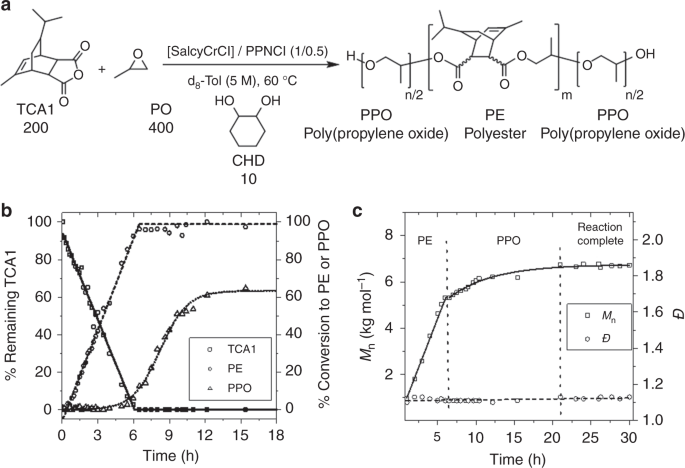
Authors (4): T. Stößer, G. S. Sulley, G. L. Gregory, C. K. Williams
Themes: Transformations DOI: 10.1038/s41467-019-10481-w
Citations: 112
Pub type: journal-article
Pub year: 2019
Publisher: Springer Science and Business Media LLC
Issue: 1
License: [{"start"=>{"date-parts"=>[[2019, 6, 17]], "date-time"=>"2019-06-17T00:00:00Z", "timestamp"=>1560729600000}, "content-version"=>"tdm", "delay-in-days"=>0, "URL"=>"https://creativecommons.org/licenses/by/4.0"}, {"start"=>{"date-parts"=>[[2019, 6, 17]], "date-time"=>"2019-06-17T00:00:00Z", "timestamp"=>1560729600000}, "content-version"=>"vor", "delay-in-days"=>0, "URL"=>"https://creativecommons.org/licenses/by/4.0"}]
Publication date(s): 2019/12/17 (online)
Pages:
Volume: 10 Issue: 1
Journal: Nature Communications
URL: http://dx.doi.org/10.1038/s41467-019-10481-wOxygenated block polyols are versatile, potentially bio-based and/or degradable materials widely applied in the manufacture of coatings, resins, polyurethanes and other products. Typical preparations involve multistep syntheses and/or macroinitiator approaches. Here, a straightforward and well-controlled one-pot synthesis of ABA triblocks, namely poly(ether-b-ester-b-ether), and ABCBA pentablocks, of the form poly(ester-b-ether-b-ester’-b-ether-b-ester), using a commercial chromium catalyst system is described. The polymerization catalysis exploits mechanistic switches between anhydride/epoxide ring-opening copolymerization, epoxide ring-opening polymerization and lactone ring-opening polymerization without requiring any external stimuli. Testing a range of anhydrides, epoxides and chain-transfer agents reveals some of the requirements and guidelines for successful catalysis. Following these rules of switch catalysis with multiple monomer additions allows the preparation of multiblock polymers of the form (ABA)n up to 15 blocks. Overall, this switchable catalysis delivers polyols in a straightforward and highly controlled manner. As proof of potential for the materials, methods to post-functionalize and/or couple the polyols to make higher polymers are demonstrated. Multiblock oxygenated polyols often show better properties than the constituent polyols, but their synthesis can be complex and difficult. Here a switchable catalysis concept is described which allows for the efficient preparation of multiblock poly(ether-b-ester) materials starting from mixtures of common monomers.
| Name | Description | Publised |
|---|---|---|
| 41467_2019_10481_MOESM1_ESM.pdf | Supl. data for Easy access to oxygenated block polymers via switchable c... | 2019 |
<< Previous Back Next >>